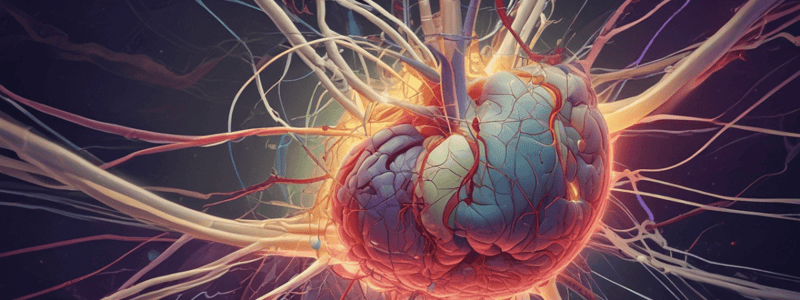Podcast
Questions and Answers
Which structure forms the roof of the third ventricle?
Which structure forms the roof of the third ventricle?
- Posterior commissure
- Ependyma invaginated by pia mater (correct)
- Anterior commissure
- Hypothalamus
What is the primary function of the choroid plexus in the ventricles?
What is the primary function of the choroid plexus in the ventricles?
- To provide structural support
- To regulate blood flow
- To facilitate neural signaling
- To produce cerebrospinal fluid (correct)
Which of the following structures is NOT part of the lateral ventricles?
Which of the following structures is NOT part of the lateral ventricles?
- Hippocampus
- Thalamus (correct)
- Caudate nucleus
- Atrium
Which structure connects the lateral ventricles to the third ventricle?
Which structure connects the lateral ventricles to the third ventricle?
What anatomical region does the third ventricle communicate with inferiorly?
What anatomical region does the third ventricle communicate with inferiorly?
Which part of the brain is primarily responsible for the floor of the third ventricle?
Which part of the brain is primarily responsible for the floor of the third ventricle?
Which of these structures is part of the diencephalon?
Which of these structures is part of the diencephalon?
What role does the interthalamic adhesion play in the anatomy of the third ventricle?
What role does the interthalamic adhesion play in the anatomy of the third ventricle?
What is the main function of the choroid plexus in the ventricular system?
What is the main function of the choroid plexus in the ventricular system?
How many parts does the lateral ventricle consist of?
How many parts does the lateral ventricle consist of?
Where does the flow of cerebrospinal fluid occur after it is produced?
Where does the flow of cerebrospinal fluid occur after it is produced?
Which embryonic structure do the ventricles of the brain derive from?
Which embryonic structure do the ventricles of the brain derive from?
What is hydrocephalus primarily characterized by?
What is hydrocephalus primarily characterized by?
The interventricular foramina connects which two structures?
The interventricular foramina connects which two structures?
Which of the following correctly describes the shape of the lateral ventricles?
Which of the following correctly describes the shape of the lateral ventricles?
What role do the foramina in the fourth ventricle play?
What role do the foramina in the fourth ventricle play?
What is the role of the inferior medullary velum?
What is the role of the inferior medullary velum?
Which structure contains the median aperture of Magendie?
Which structure contains the median aperture of Magendie?
What is the relationship between the inferior medullary velum and the 4th ventricle?
What is the relationship between the inferior medullary velum and the 4th ventricle?
Which statement accurately describes the composition of the caudal part of the inferior medullary velum?
Which statement accurately describes the composition of the caudal part of the inferior medullary velum?
Where does the median aperture of Magendie open?
Where does the median aperture of Magendie open?
Which structure is described as being attached to the cerebellum rostrally?
Which structure is described as being attached to the cerebellum rostrally?
What is the ependymal part of the inferior medullary velum continuous with?
What is the ependymal part of the inferior medullary velum continuous with?
Which of the following is NOT associated with the inferior medullary velum?
Which of the following is NOT associated with the inferior medullary velum?
Flashcards are hidden until you start studying
Study Notes
Ventricular System Overview
- Comprises interconnecting chambers and channels in the brain, derived from the embryonic neural tube.
- Central canal in the spinal cord represents the ventricular system.
- Lined with ependyma and filled with cerebrospinal fluid (CSF).
- Contains choroid plexus which produces CSF at a rate of 500 to 700 ml/day.
- Communicates with subarachnoid space through foramina in the fourth ventricle.
Lateral Ventricles
- Paired, C-shaped structures located within cerebral hemispheres, derived from telencephalon.
- Communicate with the third ventricle via the interventricular foramina (of Monro).
- Consist of five parts: frontal horn, body, temporal horn, atrium, and inferior horn.
- Alveus contains a glomus, a large tuft of choroid plexus that is calcified in adults.
Third Ventricle
- A midline, slit-like cavity located within the diencephalon, derived embryonically from diencephalon.
- Communicates with lateral ventricles through interventricular foramina and with the fourth ventricle via the cerebral aqueduct.
- Roof formed by ependyma, with invaginated pia mater on each side.
- Floor formed by hypothalamus and subthalamus; walls consist of lamina terminalis and interthalamic adhesion.
Fourth Ventricle
- Positioned between the cerebellum and the brainstem, shaped like a diamond.
- Communicates with the third ventricle via the aqueduct of midbrain and subarachnoid space through median and lateral apertures.
- Comprised of superior medullary velum and inferior medullary velum.
- Contains median aperture (of Magendie) that opens into cerebellomedullary cistern.
Choroid Plexus and CSF
- The choroid plexus produces CSF, which circulates through the ventricular system.
- CSF acts as a cushion for the brain, providing buoyancy, stability, and nutrient transport.
- Absorption of CSF occurs into the systemic circulation via arachnoid granulations.
Hydrocephalus
- A condition characterized by the accumulation of excess CSF in the ventricles, leading to increased intracranial pressure.
- Can result from obstruction of CSF flow, overproduction, or impaired reabsorption.
- Clinical implications can include headaches, vomiting, and cognitive impairment if not treated.
Studying That Suits You
Use AI to generate personalized quizzes and flashcards to suit your learning preferences.




